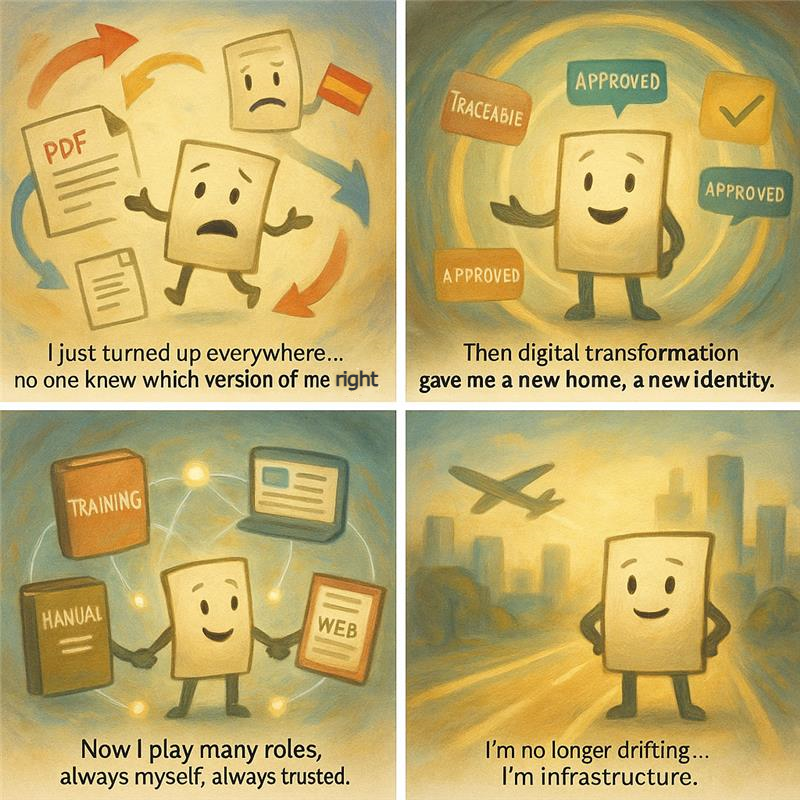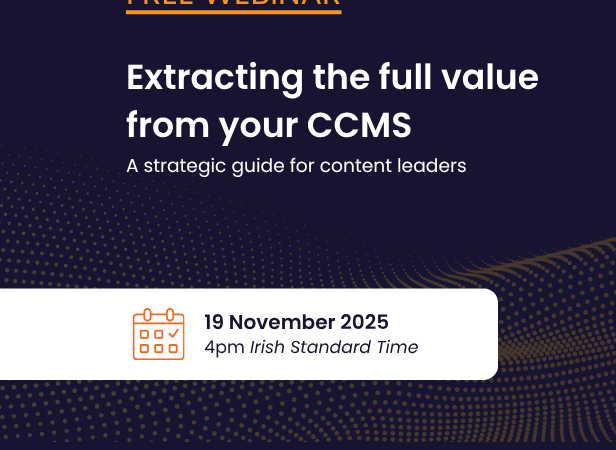We usually think of content as something static. A PDF. A web page. A slide deck. A manual. It gets created, published, and then it just… turns up.
Sometimes in SharePoint. Sometimes in a DAM. Sometimes in a training course. Sometimes in your inbox at midnight.
And here’s the truth: most content doesn’t really know why it shows up where it does. It just appears, copied, pasted, duplicated, and dropped into different places, often without purpose.
That’s life for content today: scattered, random, untraceable and expensive, risky, and slow.
But imagine the shift when content becomes structured. Suddenly, it knows where it belongs and why it’s there. It knows it’s been approved. It knows when it’s reused, and that it’s the same version everywhere. It’s not random anymore. It has a purpose.
So, to make this real, let’s hear it from the inside. Here’s my story…
My Early Life – Just Words
Hi, I’m a Product Overview.
When I was born, I was just a few sentences in Microsoft Word. Someone typed me out and handed me over. Soon, I was dressed up in a shiny PDF and sent out into the world. At first, I thought I’d made it. But then things got… weird.

My Confusing Adolescence – Random Holidays Everywhere
I started popping up all over the place, without warning.
One week, I’d turn up in a technical manual. Next, I’d sneak into a PowerPoint deck. Suddenly, I’d find myself translated into Spanish or French, like I’d gone on holiday without even packing a bag.
But here’s the thing: I didn’t know why. I didn’t know if I was supposed to be there. And worse, I didn’t know if I was even correct anymore.
There were always multiple versions of me floating around, like digital twins, some accurate, some outdated, some half-changed. But none of us knew which one was the “real me.”
I had no memory, no traceability, no purpose. I was just content, wandering aimlessly. And for a regulated company, that’s not just confusing, it’s dangerous.
My Turning Point – Digital Transformation Stepped In

And then, everything changed.
Digital transformation felt like being adopted by new parents, knowledge parents. They gave me structure, metadata, and governance.
Suddenly, I wasn’t just drifting anymore. I had an identity. And I started saving time, cutting translation costs, and speeding up approvals.
I knew who authored me, who approved me, and why I existed.
I knew which of my versions was the most recent.
I even knew where my old versions were hiding, and I could politely say: “Sorry, you’re outdated, time to retire.”
For the first time, I had full traceability, and I was being found!
My New Life – Connected Knowledge
Life got richer. I wasn’t just “the overview” stuck in a PDF.
With my training friends, I became an eLearning intro.
With my technical friends, I became part of a system manual.
With my marketing friends, I introduced a product webpage.
With my global friends, I was translated into French, Spanish, and Mandarin and I always knew where those translations lived, and that they were approved.
I was the same me, reused across all those places, not a clone, not a copy-paste, but a traceable, connected version of myself.
For the first time, I wasn’t drifting. I was purposeful, I had joined the Single Source of Truth family and that felt great!
My Superpowers – What I Can Do Now
And once I became knowledgeable, I discovered my real superpowers:
- Transparency: I can show who created me, who approved me, what updates were made and why I existed, so audits are faster and compliance risks drop.
- Traceability: I can reveal where I’ve been used, in manuals, webpages, and training, so duplication disappears and updates happen everywhere at once.
- Findability: I carry tags and metadata that make me discoverable instantly, by people and by AI, so teams move faster and stop reinventing the wheel.
- Measurement: I can prove my impact, how often I’m reused, how quickly I’m adopted, and whether I make a difference, so budgets get defended with real data.
- AI Readiness: I’m structured and explainable, ready to fuel automation and personalization, so future projects aren’t just possible, they’re trusted.
I wasn’t just content anymore. I was knowledgeable.
And knowledge comes with responsibility and influence.
My Next Chapter – Life with GenAI
And then something new arrived.
GenAI.
At first, I wasn’t sure what it meant for me. But I quickly learned that because I was structured and governed, I could be reshaped safely.
With the right guardrails, GenAI could take me and:
- Reframe me for different audiences, from engineers to executives.
- Summarize me into bite-sized insights.
- Expand me into training modules or support chat answers.
- Translate me faster and cheaper, without losing accuracy.
Instead of fearing duplication or distortion, I could finally be reused intelligently.
Because I had structure, metadata, and traceability, GenAI didn’t make things up about me; it was building on trusted knowledge: me.
That’s when I realized: I wasn’t just powering documents. I was powering intelligence.
My Purpose – From Knowledge to Infrastructure
My Purpose – From Knowledge to Infrastructure

Today, I’m not a random traveller anymore. I’m part of a wider content infrastructure.
I’m part of a system that regulators can trust, translators can rely on, and teams can build with confidence.
If I change, my friends in manuals and training change too.
If I’m translated, my versions know where they live and that they’re consistent.
If I’m reused, I can prove I’m the right one, always the latest, always approved.
I’m still a Product Overview, but I’m no longer just content.
I’m the runway your information takes off from.
The Bigger Picture – Why My Story Matters
If my life has taught me anything, it’s this: every piece of content deserves a purpose.
Because when content has a home, it stops being a burden. It stops showing up randomly, is mistranslated, and is duplicated across five systems. Instead, it becomes a reliable partner: transparent, traceable, reusable, and measurable.
That’s when people say: “Ah, I get it. Content isn’t just output, it’s infrastructure. And infrastructure is what builds trust, compliance, and confidence in the age of AI.
The Epilogue
One day I will retire, I will be superseded by a better version of myself but I will be remembered in the archives for the life I had in the age of transformation…
I began life as words.
I became fragmented and confused.
Then digital transformation gave me structure, identity, and purpose.
Now I am knowledgeable.
Now I am infrastructure.
And when you treat content this way, you unlock more than efficiency. You unlock trust, visibility, and confidence.
FAQs
1. What happens to content after it’s published?
Most content doesn’t have a clear purpose or traceability after it’s published. It often gets copied, pasted, and duplicated across multiple places like PDFs, SharePoint, and training materials—creating inconsistent versions. Structured content solves this problem by making information traceable, reusable, and measurable.
2. What is structured content and why does it matter?
Structured content means creating information in reusable, modular pieces with metadata and governance. It ensures every version stays accurate, approved, and connected across channels—reducing risk, translation costs, and manual work while improving trust and efficiency.
3. How does digital transformation change the life of content?
Digital transformation gives content identity and intelligence. With structure and metadata, content becomes traceable and AI-ready—it knows who created it, where it’s used, and how it performs. This shift turns content from scattered documents into a trusted knowledge infrastructure.





